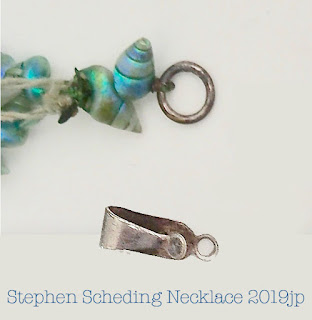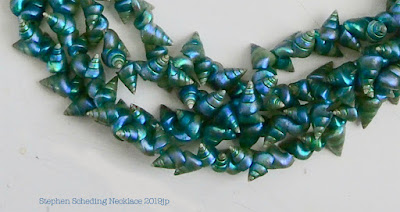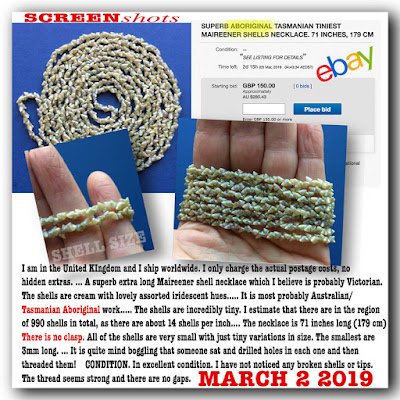John McPhee reference. MARCH 2019
See website at www.artresearch.com.au -
the website hosts a database on Australian art which is free to use to
find bibliographical and biographical information on Australian artists (still
in development, but very good for early Australian artists, particularly lesser
known ones).
Recently, at an auction, this shell necklace was acquired. The purchasers have been looking for something like this since
writing a book on Duterrau and Tasmanian history. See
- TRUGANINI NECKLACES ... http://truganininecklaces.blogspot.com/
- NECKLACEMAKING AND PLACEDNESS IN TASMANIA ... ... http://revistes.ub.edu/index.php/coolabah/article/view/15601/18727
- PLACE, PLACEMAKING, PLACEMARKING & PLACEDNESS ... http://revistes.ub.edu/index.php/coolabah/article/view/15543/18695
- MAIREENER MUSINGS ... http://maireenermusing.blogspot.com/
- THE MAWLE REPORT ... http://themawlereport.blogspot.com/
- SHELL NECKLACE FILE ... http://shellnecklacefile.blogspot.com/
- THE SHELL NECKLACE ROBBERY 1907 ... http://shellnecklacerobbery.blogspot.com/
- QVMAG STRUNG HISTORIES ... http://qvmagstrunghistories.blogspot.com/
TASMANIAN SHELL NECKLACE RESEARCH ... CLICK HERE
When showing John the necklace the stringing broke. That’s another story. I will
have to find someone to restring it. ... LOLA GREENO HAS SAID SHE WOULD RESTRING THIS NECKLACE
But John has wondered whether the necklace might have 'Sargison
silverwork? Or is it a souvenir of the islands?’
Some images.... See notes below
click on an image to enlarge
click on an image to enlarge
click on an image to enlarge
click on an image to enlarge
Notes
- This necklace has all the characteristics of what has come to known as a "HOBART NECKLACE". Such necklaces are relatively common in the 'international antique market' typically turning up in the USA and the UK.
- Very often they are marketed, and wrongly, as something like "Tasmanian Aboriginal Shell Necklace" presumably on the back of the Tasmanian Aboriginal women's necklaces winning recognition and winning high prices for their work ... Lola Greeno for example
- This example is somewhat unusual in that it is dyed, presumably with aniline dye, as were a portion of the production of 'Hobart Necklaces'. This necklace appears as if it may have been made late 19th/early 20th C given the appearance of the dye. In the 1960s/70s it is reported that a 'souvenir maker' Bertie May was producing such necklaces but the application of the dye was less subtle and somewhat garish ... LINK
- The clasp would seem to be late 19th/early 20th C given the techniques used. Given that the necklace is clearly Tasmanian and most probably part of the Hobart Necklace market, circumstantially, it may well have been restrung by Sargison's shop in Hobart – Harold Francis Sargison (1885-1983) Nonetheless, there would be other candidates. With regular wear these necklaces would have required restringing quite frequently, perhaps annually, thus offering an opportunity to double the strands and add a clasp. It seems that Hobart Necklaces were 'endless' like the 'Aboriginal necklaces' that provided a 'model as a cultural identifier'.
- FURNEAUX NECKLACES The Aboriginal women on 'the islands' are noted for their necklace making. The carry on, and have expanded, a palawa cultural practice that has come to be one of Tasmanian Aboriginal people's cultural identifier with a history reaching back at least 40 thousand years. Arguably their necklaces are a part of the oldest known living culture on the planet. Their necklaces use a range of shells to be found on the islands along with 'maireener shells' of the kind used in this necklace but as far as it is known none were dyed. Neither did these women participate in the 'HOBART NECKLACE TRADE' albeit, in Tasmania, some may have found there way in via a 'back door'. NONETHELESS, the 'island women' did engage in a 'necklace trade' of their own basically centred in Launceston with largely a very local clientele. Lola Greeno is currently the most prominent maker with a background in the islands and she uses the full range of shells use by the island women.
 |
| CLICK HERE FOR MORE INFORMATION |
Random eBAY Find
A HOBART NECKLACE
and a very nice one







